Marta Gomez-Barrero
Reversing the Irreversible: A Survey on Inverse Biometrics
Jan 05, 2024Abstract:With the widespread use of biometric recognition, several issues related to the privacy and security provided by this technology have been recently raised and analysed. As a result, the early common belief among the biometrics community of templates irreversibility has been proven wrong. It is now an accepted fact that it is possible to reconstruct from an unprotected template a synthetic sample that matches the bona fide one. This reverse engineering process, commonly referred to as \textit{inverse biometrics}, constitutes a severe threat for biometric systems from two different angles: on the one hand, sensitive personal data (i.e., biometric data) can be derived from compromised unprotected templates; on the other hand, other powerful attacks can be launched building upon these reconstructed samples. Given its important implications, biometric stakeholders have produced over the last fifteen years numerous works analysing the different aspects related to inverse biometrics: development of reconstruction algorithms for different characteristics; proposal of methodologies to assess the vulnerabilities of biometric systems to the aforementioned algorithms; development of countermeasures to reduce the possible effects of attacks. The present article is an effort to condense all this information in one comprehensive review of: the problem itself, the evaluation of the problem, and the mitigation of the problem. The present article is an effort to condense all this information in one comprehensive review of: the problem itself, the evaluation of the problem, and the mitigation of the problem.
* 18 pages, journal, survey
General Framework to Evaluate Unlinkability in Biometric Template Protection Systems
Nov 08, 2023Abstract:The wide deployment of biometric recognition systems in the last two decades has raised privacy concerns regarding the storage and use of biometric data. As a consequence, the ISO/IEC 24745 international standard on biometric information protection has established two main requirements for protecting biometric templates: irreversibility and unlinkability. Numerous efforts have been directed to the development and analysis of irreversible templates. However, there is still no systematic quantitative manner to analyse the unlinkability of such templates. In this paper we address this shortcoming by proposing a new general framework for the evaluation of biometric templates' unlinkability. To illustrate the potential of the approach, it is applied to assess the unlinkability of four state-of-the-art techniques for biometric template protection: biometric salting, Bloom filters, Homomorphic Encryption and block re-mapping. For the last technique, the proposed framework is compared with other existing metrics to show its advantages.
Introduction to Presentation Attack Detection in Iris Biometrics and Recent Advances
Nov 24, 2021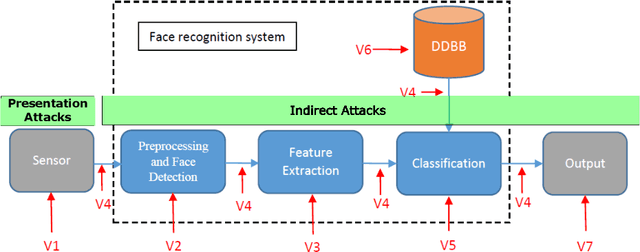
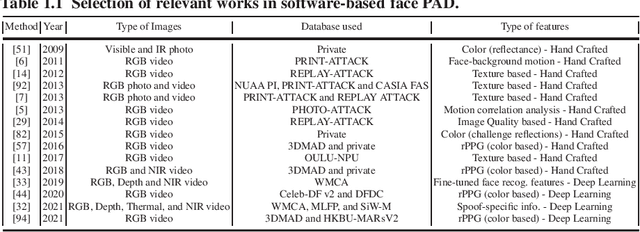
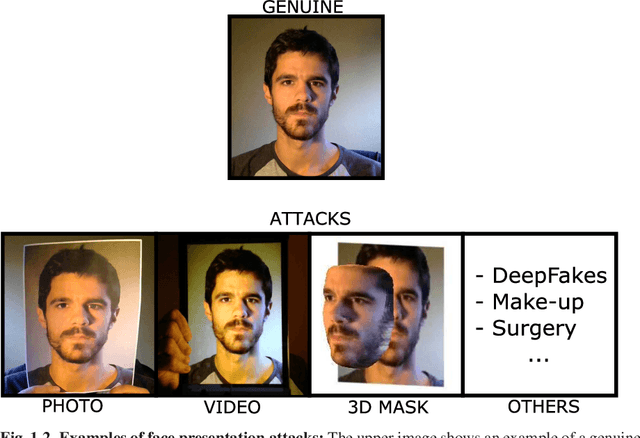

Abstract:Iris recognition technology has attracted an increasing interest in the last decades in which we have witnessed a migration from research laboratories to real world applications. The deployment of this technology raises questions about the main vulnerabilities and security threats related to these systems. Among these threats presentation attacks stand out as some of the most relevant and studied. Presentation attacks can be defined as presentation of human characteristics or artifacts directly to the capture device of a biometric system trying to interfere its normal operation. In the case of the iris, these attacks include the use of real irises as well as artifacts with different level of sophistication such as photographs or videos. This chapter introduces iris Presentation Attack Detection (PAD) methods that have been developed to reduce the risk posed by presentation attacks. First, we summarise the most popular types of attacks including the main challenges to address. Secondly, we present a taxonomy of Presentation Attack Detection methods as a brief introduction to this very active research area. Finally, we discuss the integration of these methods into Iris Recognition Systems according to the most important scenarios of practical application.
Differential Anomaly Detection for Facial Images
Oct 07, 2021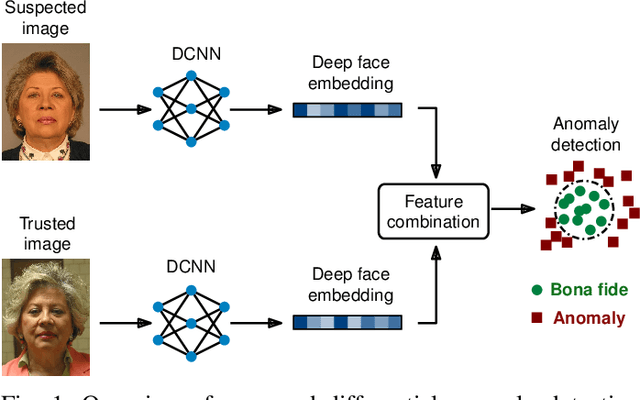
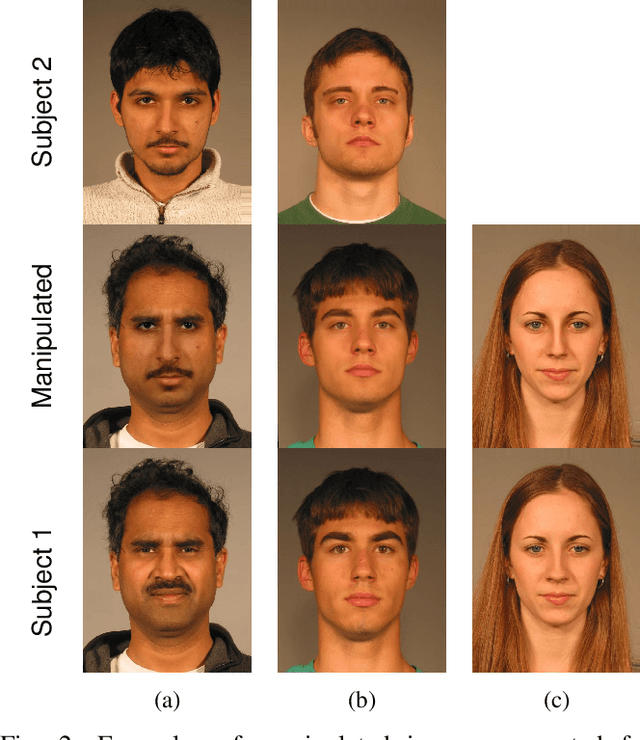
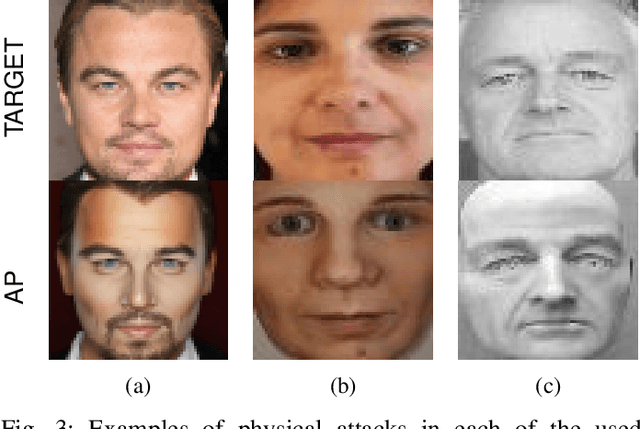
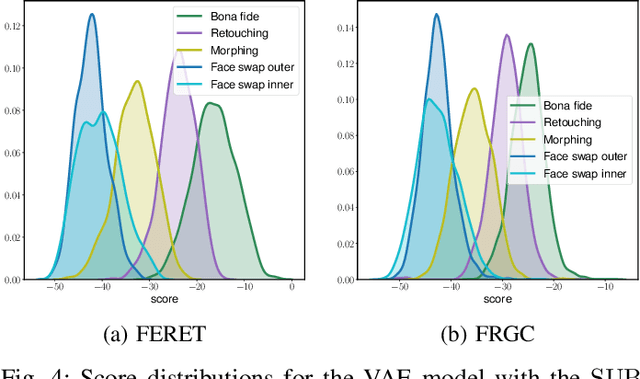
Abstract:Due to their convenience and high accuracy, face recognition systems are widely employed in governmental and personal security applications to automatically recognise individuals. Despite recent advances, face recognition systems have shown to be particularly vulnerable to identity attacks (i.e., digital manipulations and attack presentations). Identity attacks pose a big security threat as they can be used to gain unauthorised access and spread misinformation. In this context, most algorithms for detecting identity attacks generalise poorly to attack types that are unknown at training time. To tackle this problem, we introduce a differential anomaly detection framework in which deep face embeddings are first extracted from pairs of images (i.e., reference and probe) and then combined for identity attack detection. The experimental evaluation conducted over several databases shows a high generalisation capability of the proposed method for detecting unknown attacks in both the digital and physical domains.
SVC-onGoing: Signature Verification Competition
Aug 13, 2021



Abstract:This article presents SVC-onGoing, an on-going competition for on-line signature verification where researchers can easily benchmark their systems against the state of the art in an open common platform using large-scale public databases, such as DeepSignDB and SVC2021_EvalDB, and standard experimental protocols. SVC-onGoing is based on the ICDAR 2021 Competition on On-Line Signature Verification (SVC 2021), which has been extended to allow participants anytime. The goal of SVC-onGoing is to evaluate the limits of on-line signature verification systems on popular scenarios (office/mobile) and writing inputs (stylus/finger) through large-scale public databases. Three different tasks are considered in the competition, simulating realistic scenarios as both random and skilled forgeries are simultaneously considered on each task. The results obtained in SVC-onGoing prove the high potential of deep learning methods in comparison with traditional methods. In particular, the best signature verification system has obtained Equal Error Rate (EER) values of 3.33% (Task 1), 7.41% (Task 2), and 6.04% (Task 3). Future studies in the field should be oriented to improve the performance of signature verification systems on the challenging mobile scenarios of SVC-onGoing in which several mobile devices and the finger are used during the signature acquisition.
ICDAR 2021 Competition on On-Line Signature Verification
Jun 01, 2021

Abstract:This paper describes the experimental framework and results of the ICDAR 2021 Competition on On-Line Signature Verification (SVC 2021). The goal of SVC 2021 is to evaluate the limits of on-line signature verification systems on popular scenarios (office/mobile) and writing inputs (stylus/finger) through large-scale public databases. Three different tasks are considered in the competition, simulating realistic scenarios as both random and skilled forgeries are simultaneously considered on each task. The results obtained in SVC 2021 prove the high potential of deep learning methods. In particular, the best on-line signature verification system of SVC 2021 obtained Equal Error Rate (EER) values of 3.33% (Task 1), 7.41% (Task 2), and 6.04% (Task 3). SVC 2021 will be established as an on-going competition, where researchers can easily benchmark their systems against the state of the art in an open common platform using large-scale public databases such as DeepSignDB and SVC2021_EvalDB, and standard experimental protocols.
On the Generalisation Capabilities of Fisher Vector based Face Presentation Attack Detection
Mar 02, 2021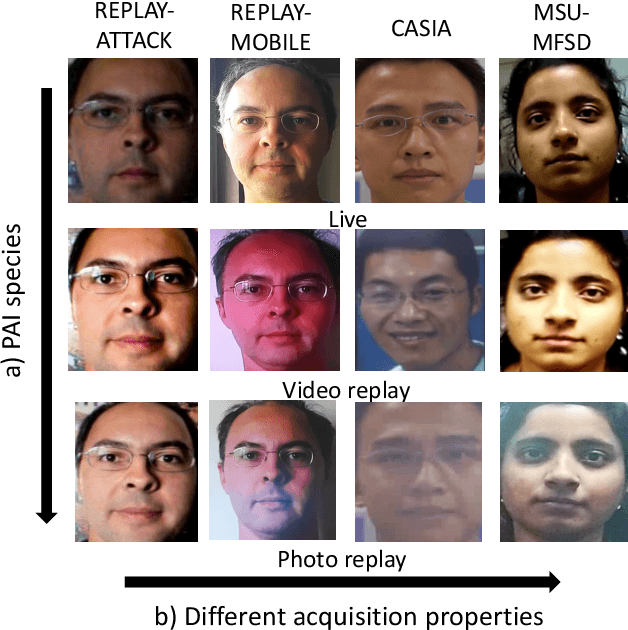



Abstract:In the last decades, the broad development experienced by biometric systems has unveiled several threats which may decrease their trustworthiness. Those are attack presentations which can be easily carried out by a non-authorised subject to gain access to the biometric system. In order to mitigate those security concerns, most face Presentation Attack Detection techniques have reported a good detection performance when they are evaluated on known Presentation Attack Instruments (PAI) and acquisition conditions, in contrast to more challenging scenarios where unknown attacks are included in the test set. For those more realistic scenarios, the existing algorithms face difficulties to detect unknown PAI species in many cases. In this work, we use a new feature space based on Fisher Vectors, computed from compact Binarised Statistical Image Features histograms, which allow discovering semantic feature subsets from known samples in order to enhance the detection of unknown attacks. This new representation, evaluated for challenging unknown attacks taken from freely available facial databases, shows promising results: a BPCER100 under 17% together with an AUC over 98% can be achieved in the presence of unknown attacks. In addition, by training a limited number of parameters, our method is able to achieve state-of-the-art deep learning-based approaches for cross-dataset scenarios.
Biometrics in the Era of COVID-19: Challenges and Opportunities
Feb 18, 2021



Abstract:Since early 2020 the COVID-19 pandemic has had a considerable impact on many aspects of daily life. A range of different measures have been implemented worldwide to reduce the rate of new infections and to manage the pressure on national health services. A primary strategy has been to reduce gatherings and the potential for transmission through the prioritisation of remote working and education. Enhanced hand hygiene and the use of facial masks have decreased the spread of pathogens when gatherings are unavoidable. These particular measures present challenges for reliable biometric recognition, e.g. for facial-, voice- and hand-based biometrics. At the same time, new challenges create new opportunities and research directions, e.g. renewed interest in non-constrained iris or periocular recognition, touch-less fingerprint- and vein-based authentication and the use of biometric characteristics for disease detection. This article presents an overview of the research carried out to address those challenges and emerging opportunities.
Selfie Periocular Verification using an Efficient Super-Resolution Approach
Feb 16, 2021


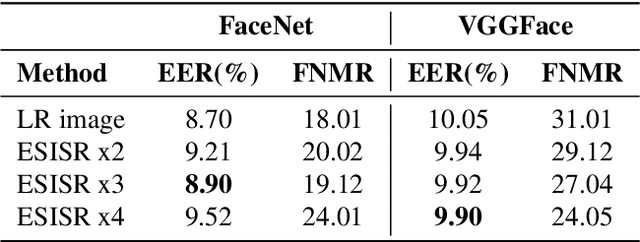
Abstract:Selfie-based biometrics has great potential for a wide range of applications from marketing to higher security environments like online banking. This is now especially relevant since e.g. periocular verification is contactless, and thereby safe to use in pandemics such as COVID-19. However, selfie-based biometrics faces some challenges since there is limited control over the data acquisition conditions. Therefore, super-resolution has to be used to increase the quality of the captured images. Most of the state of the art super-resolution methods use deep networks with large filters, thereby needing to train and store a correspondingly large number of parameters, and making their use difficult for mobile devices commonly used for selfie-based. In order to achieve an efficient super-resolution method, we propose an Efficient Single Image Super-Resolution (ESISR) algorithm, which takes into account a trade-off between the efficiency of the deep neural network and the size of its filters. To that end, the method implements a novel loss function based on the Sharpness metric. This metric turns out to be more suitable for increasing the quality of the eye images. Our method drastically reduces the number of parameters when compared with Deep CNNs with Skip Connection and Network (DCSCN): from 2,170,142 to 28,654 parameters when the image size is increased by a factor of x3. Furthermore, the proposed method keeps the sharp quality of the images, which is highly relevant for biometric recognition purposes. The results on remote verification systems with raw images reached an Equal Error Rate (EER) of 8.7% for FaceNet and 10.05% for VGGFace. Where embedding vectors were used from periocular images the best results reached an EER of 8.9% (x3) for FaceNet and 9.90% (x4) for VGGFace.
On the Generalisation Capabilities of Fingerprint Presentation Attack Detection Methods in the Short Wave Infrared Domain
Oct 19, 2020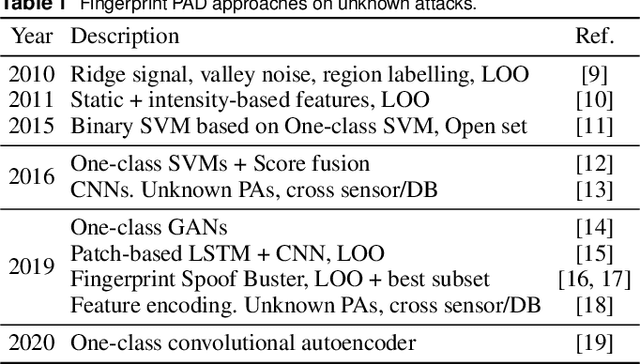
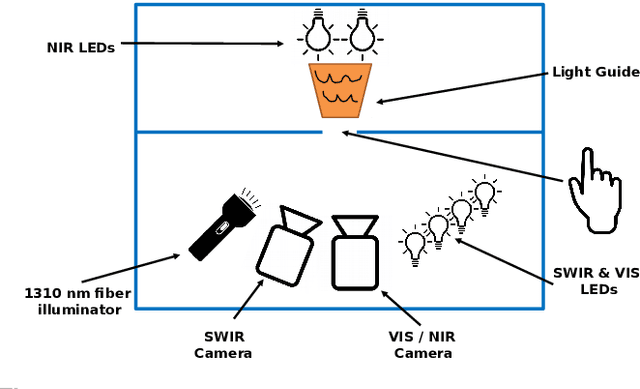
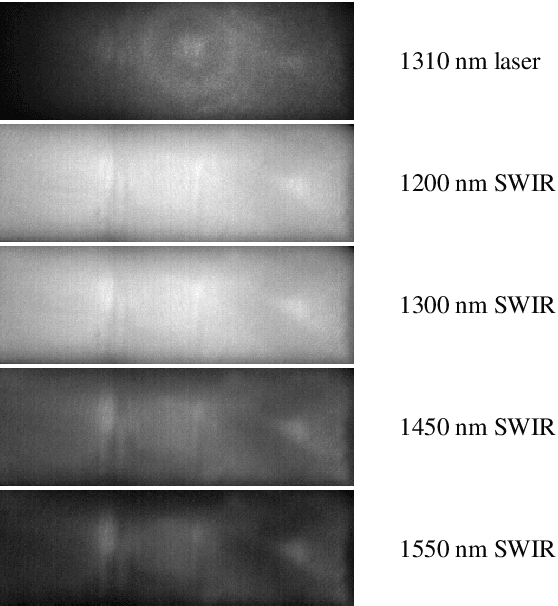
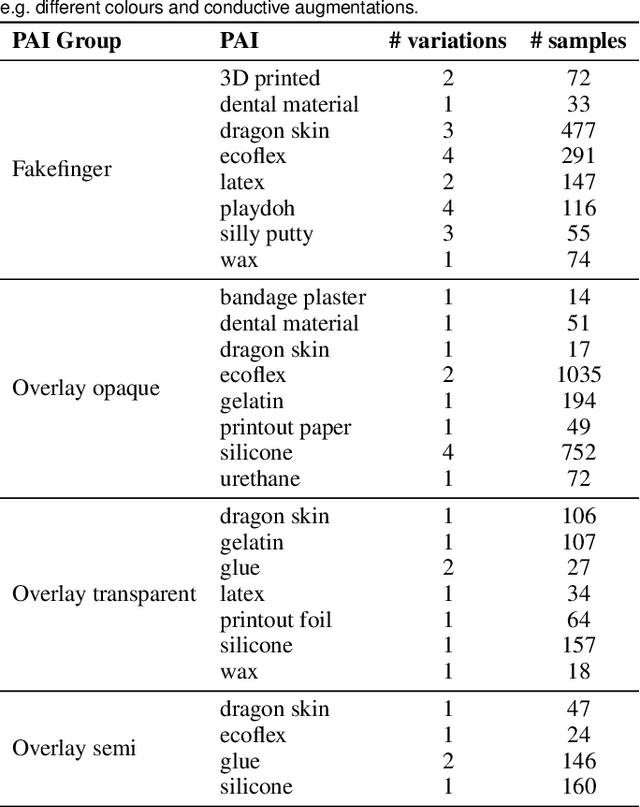
Abstract:Nowadays, fingerprint-based biometric recognition systems are becoming increasingly popular. However, in spite of their numerous advantages, biometric capture devices are usually exposed to the public and thus vulnerable to presentation attacks (PAs). Therefore, presentation attack detection (PAD) methods are of utmost importance in order to distinguish between bona fide and attack presentations. Due to the nearly unlimited possibilities to create new presentation attack instruments (PAIs), unknown attacks are a threat to existing PAD algorithms. This fact motivates research on generalisation capabilities in order to find PAD methods that are resilient to new attacks. In this context, we evaluate the generalisability of multiple PAD algorithms on a dataset of 19,711 bona fide and 4,339 PA samples, including 45 different PAI species. The PAD data is captured in the short wave infrared domain and the results discuss the advantages and drawbacks of this PAD technique regarding unknown attacks.
 Add to Chrome
Add to Chrome Add to Firefox
Add to Firefox Add to Edge
Add to Edge